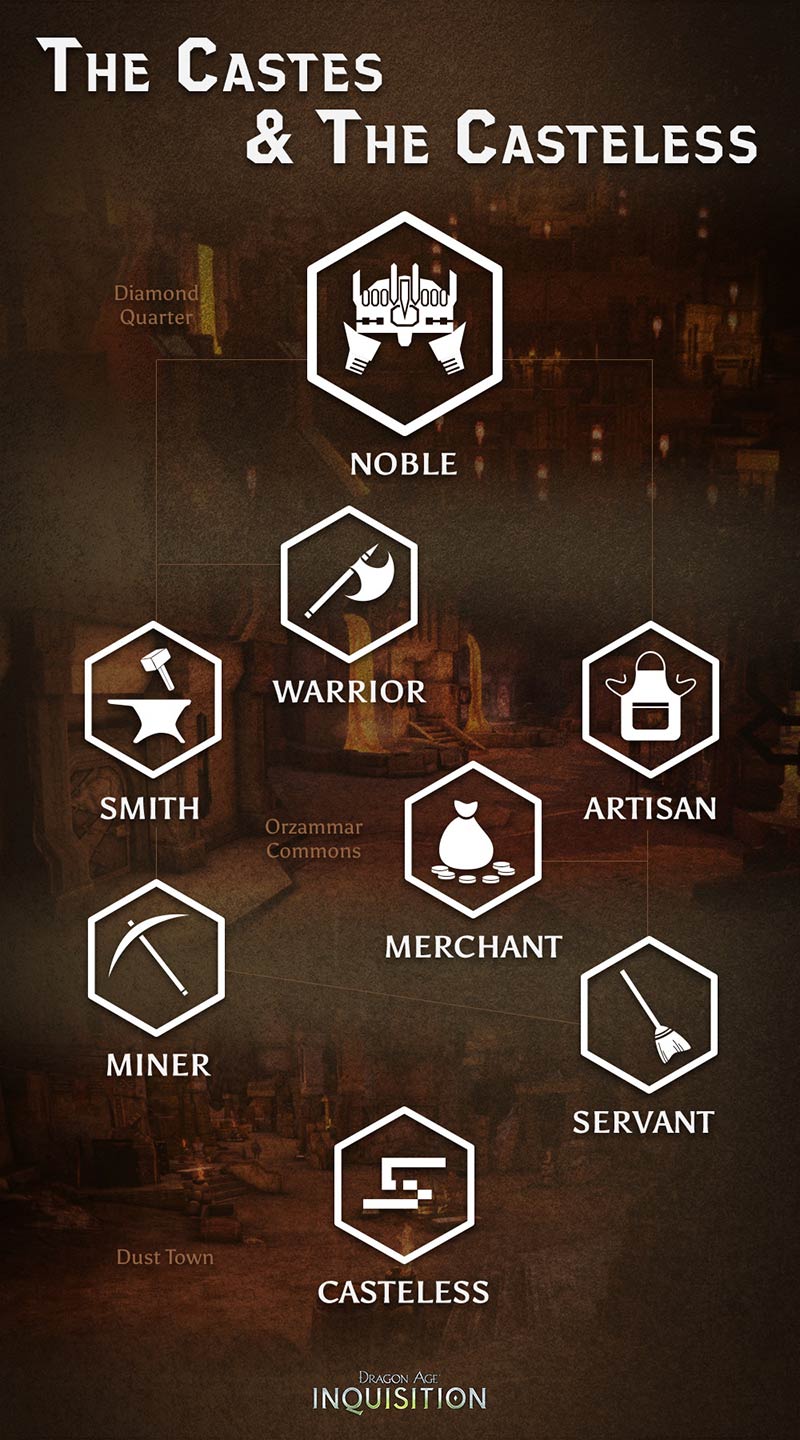Know Your Lore: The Caste & The Casteless

Visitors to Orzammar should keep in mind that the hierarchies of dwarven society are much more complex than our own. It is easy to gravely insult a man simply by mistaking his position. Since this can lead to unnecessary loss of life and limbs, I will attempt to mitigate the danger for my fellow travelers.
The society of Orzammar is divided into nobles, warriors, smiths, artisans, miners, merchants, and servants. Now, you are undoubtedly saying to yourself, "We have all those divisions among our own people." This is a dangerous misconception. Certainly, we do have nobility, artisans, merchants, and these positions are largely inherited from our parents. However, the younger children of noblemen often choose to be artisans or soldiers. The sons of merchants may join the army, or become servants, or apprentice themselves to a craftsman. This is all freely chosen. Limited, perhaps, by the circumstances of birth, but still chosen.
What is a matter of choice for most human folk is dictated entirely by birth for dwarves. No one may become a smith who was not born to Smith Caste parents. A servant who marries a noblewoman will never be a noble himself, and although his daughters would be nobles, his sons would be servants, for daughters inherit the caste of their mother, while sons inherit the caste of their father.
—From In Pursuit of Knowledge: The Travels of a Chantry Scholar by Brother Genitivi

The caste system in Orzammar includes many groups of privilege--the nobility and the warriors above all others, but to a lesser degree the merchants and the smiths and the miners. Tradition establishes a clear hierarchy. But as in any culture with an upper class, there is also a clear underclass. These unfortunates, the so-called "casteless," are believed to be descendants of criminals and other undesirables. They have been looked down upon since Orzammar's foundation. They have taken up residence in a place called "Dust Town," a crumbling ruin on the fringe of Orzammar's common areas.
Orzammar society considers these casteless lower than even the Servant Caste (indeed, the casteless are not allowed to become servants, as it is too honorable a position). They are seen as little better than animals, their faces branded at birth to mark them as the bastard children of the kingdom. Their home district, little more than a slum, is a haven for crime, organized and otherwise. Orzammar's guards seemingly cannot be bothered to patrol its streets. The best that most casteless dwarves can hope for is a life at the whim of a local crime lord, ended abruptly by violence or an overabundance of toxic lichen ale.
Even so, there is some hope for the casteless, a dangling rope that offers a way up into greater Orzammar society. Since a dwarf's caste is determined by the parent of the same sex, the male child of a nobleman is part of that noble's house and caste. Strangely, it is acceptable for casteless women to train in the arts of courtly romance to woo nobles and warriors; they are known as "noble hunters." Any male born from such a union is considered a joyous event, considering the low rate of dwarven fertility. The mother and entire family are then taken in by the father's house, although they retain their caste.
The dwarves we know on the surface are also considered casteless once they leave Orzammar, although this is only relevant to those who return--if they are allowed to return at all. Dwarves who leave for the surface (the "sun-touched," as they're often called behind their backs) lose their connection to the Stone and the favor of the ancestors, and thus are worthy of little more than pity, for upon dying they are said to be lost to the Stone forever. Put that way, it seems a sad existence indeed.
—From Stone Halls of the Dwarves by Brother Genitivi, Chantry scholar

